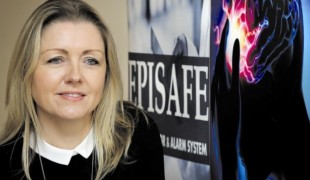- 3141
- 278
- 7
- 8
- 0
- Help Ukraine
About the solution
The DinnerUp consists of a tray attached to a column which, itself, is fixed to a wall or kitchen cabinet. The tray is then wound up and down the column by turning a handle which includes a clutch device. This way he can reach the cat’s bowls more easily and in an independent way.
"I love my cat Sylvester, but I do have difficulties looking after him. I cannot bend down to put his food on the floor and obviously, it is unhygienic to encourage him onto the kitchen work surface", Ray described.
It took Ray six years to come up with this product. He developed this solution because it was getting difficult for him to bend down to pick up his cats' food bowls.
Being a retired engineer, he first thought of a more sophisticated invention. "It was an automatic product and a bit too expensive for the market," the inventor explained.
Then Ray built the second version, which became the ultimate version of his product.
This invention won the award at a NAIDEX show at Birmingham in 2007.
Adapted from: http://bbc.in/2mvMhoN
This solution shall not include mention to the use of drugs, chemicals or biologicals (including food); invasive devices; offensive, commercial or inherently dangerous content. This solution was not medically validated. Proceed with caution! If you have any doubts, please consult with a health professional.
DISCLAIMER: This story was written by someone who is not the author of the solution, therefore please be advised that, although it was written with the utmost respect for the innovation and the innovator, there can be some incorrect statements. If you find any errors please contact the patient Innovation team via info@patient-innovation.com
-
-
348
-
0
-
4268

Collaborator Pierluigi Mantovani creates Evolution Devices - solutions that aim to transform Multiple Sclerosis Management
CAREGIVING
BODY BALANCE: Maintaining body balance
STANDING UP: Standing up from a seated position
WALKING: Walking
Multiple Sclerosis
Assistive Daily Life Device (to help ADL)
Walking Aid (wheelchair/walker/crutches)
App (Including when connected with wearable)
AI algorithm
Body-Worn solutions (Clothing, accessories, shoes, sensors...)
Restoring mobility
Regaining sensory function
Managing pain
Promoting self-management
Preserving Organ Function
Managing Neurological Disorders
Maintaining Balance and Mobility
To improve Treatment/Therapy
Preventing (Vaccination, Protection, Falls, Research/Mapping)
Raise awareness
Caregiving Support
General and Family Medicine
Internal Medicine
Medical Genetics
Neurology
Physical Medicine and Rehabilitation
United States
-
-
-
966
-
0
-
20992

System to track autistic children
CAREGIVING
COMMUNICATION: Communicating, whether by speaking, listening, or other means
Social interaction
Autism
Assistive Daily Life Device (to help ADL)
Body-Worn solutions (Clothing, accessories, shoes, sensors...)
App (Including when connected with wearable)
Anxiety
Difficulty concentrating or making decisions
Social withdrawal or isolation
Restlessness or feeling slowed down
Loss of interest or pleasure in activities (anhedonia)
Promoting self-management
Managing Neurological Disorders
Preventing (Vaccination, Protection, Falls, Research/Mapping)
Caregiving Support
Child and Adolescent Psychiatry
Medical Genetics
Neurology
Pediatrics
Psychiatry
Israel
-
-
-
717
-
0
-
12503

Device to monitor Epilepsy seizures
CAREGIVING
Epilepsy
Assistive Daily Life Device (to help ADL)
Seizures
Enhancing health literacy
Promoting self-management
Managing Neurological Disorders
To implement a diagnostic tool
To improve Treatment/Therapy
Raise awareness
Caregiving Support
General and Family Medicine
Internal Medicine
Neurology
Pediatrics
United Kingdom
-
 en
en